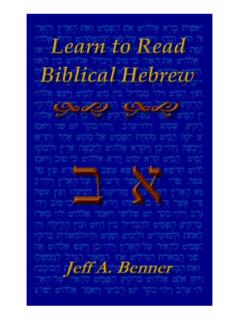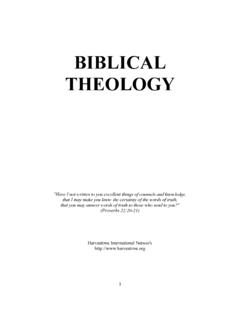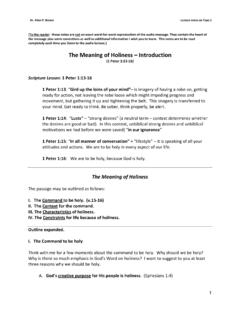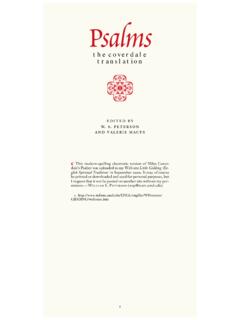Transcription of The Hebrew Vowels
1 Chapter 2 The Hebrew Vowels . You might be surprised to learn that originally theHebrew language had no written system of Vowels . This does not mean,however, that Hebrew Vowels did not exist. While they did not exist inwritten form, they had always been present in the spoken form of thelanguage. If we were to take the Vowels out of the English writingsystem, these Vowels would still be present in the spoken form. Let ususe the English translation of Deut 6:5 as an example: Love the Lordyour God with all your heart. Without the Vowels , we are left with aseries of consonants, much like the ancient written form of Hebrew : Lvth Lrd yr Gd wth ll yr hrt. In order to read this sentence out loud, youwould need to rely on your knowledge of English and supply thenecessary Vowels .
2 In the same way, when Joshua read the entire law ofMoses to the Israelites (Josh 8), he had before him a consonantal textwith no Vowels . This required Joshua to supply from memory thenecessary Vowels when reading. Fortunately for us, this is not the casetoday. In the second half of the first millennium , a group of dedicatedscribes called Masoretes became concerned with preserving the oraltradition or spoken form of Hebrew . They developed an elaborate systemof vowel notation called pointing. This pointing system was designedto preserve the spoken system of Vowels in the written text. Becausethe masoretic scribes considered the biblical text to be sacred, theirvowel symbols were designed in such a way as never to alter theoriginal consonantal text.
3 To do this, the Masoretes developed vowelsymbols that were placed under, inside (to the left) or above theconsonantal characters. Let us look once again at Deut 6:5 but this timein Hebrew . You will notice that the consonants are exactly the same inboth examples. In the second example, however, the masoretic vowelpointing system has been added. Notice that the majority of symbolsexist below the consonants with occasional symbols inside (to the left)or over the consonants. (without Vowels )8 (with Vowels )Chapter 2: The Hebrew Vowel Charts. In the following charts, the Hebrew Vowels arepresented in four major vowel classes: short, changeable long,unchangeable long and reduced. Within these vowel classes, there arefive vowel types (a, e, i, o, u), though not all are attested in each of thevowel classes.
4 Each vowel will appear with the consonant in order toshow the position of the vowel with respect to its consonant. It isimportant to note that the vowel is pronounced after the consonantwith which it is associated. For example, is pronounced ba and not aband is pronounced bo and not ob. Remember that while Hebrew iswritten from right to left, English transliteration is written from left each of the following vowel charts with care. For each vowel,you should be able to identify its vowel class, vowel name andtransliteration. The transliteration system is fairly simple for a-type Vowels are transliterated with some form of the letter a. Thisis the same for each subsequent class of Vowels . In transliteration,changeable long Vowels have a horizontal line (macron) over the letter.
5 Unchangeable long Vowels have a small upside down v (circumflex) over the letter: , , , , . Short Vowels are unaltered: a, e,i, o, u. Reduced Vowels exhibit what looks like a small u placedabove the letter: , , . For now, do not be concerned about the physicalsimilarity between the Qamets ( , changeable long ) and the QametsHatuf ( , short o). You will learn how to distinguish between them inthe next , you should begin the process of becoming familiar with thepronunciation value of each vowel. Learning the sound for each vowelwill take some time. Be 2: The Hebrew Vowel Chart 1: Short Vowel NamePronunciation Transliterationa-type Pathacha as in batae-type Seghole as in betterei-type Hireqi as in bitterio-type Qamets Hatufo as in bottleou-type Qibbutsu as in Vowel Chart 2: Changeable Long Vowels .
6 In our system ofvowel classification ( ), i-type and u-type Vowels are not attested inthe changeable long Vowel NamePronunciation Transliterationa-type Qametsa as in father e-type Tseree as in they o-type Holemo as in role Vowel Chart 3: Unchangeable Long Vowel NamePronunciation Transliterationa-type Qamets Hea as in father e-type Tsere Yode as in they Seghol Yode as in better i-type Hireq Yodi as in machine o-type Holem Wawo as in role u-type Shurequ as in ruler Chapter 2: The Hebrew Vowel Chart 4: Reduced (Hateph) Vowels . In this class, i-typeand u-type Vowels are not Vowel NamePronunciation Transliterationa-type Hateph Pathacha as in amuse e-type Hateph Seghola as in amuse o-type Hateph Qametsa as in amuse You will notice in vowel chart 4 that each reduced vowel ( , , ) exhibits a pair of vertical dots on the right side of the vowel vertical dots also occur without an accompanying vowel ( ).
7 This vowel sign is called Shewa. The Shewa is not listed in the abovevowel charts because it is not like any other vowel. It does not belongto any phonetic class: a, e, i, o, u. There are two types of Shewa inHebrew: Silent Shewa and Vocal Shewa. The Silent Shewa has a zerovalue and is never pronounced and never transliterated. The VocalShewa maintains a hurried pronunciation and sounds like the a in is transliterated either as an upside-down e ( , b#) or as a superscripte ( , b ). In the next chapter, you will learn how to distinguish betweenSilent and Vocal over the and . In some instances, when the vowel symbolHolem ( ) is used with (Sin) or (Shin), the two dots combine intoone dot over the consonant. For example, we would expect to seesomething like (y e m) with two distinct dots.
8 But the twodots will sometimes combine into a single dot ( ) which will servetwo purposes. It distinguishes between ( ) and ( ) and it alsoserves as the changeable long vowel (Holem). You will learn in thenext chapter that all initial consonants must be followed by a vowel. Giventhis rule, the dot over the , in the above example, must also functionas the Holem Forte. There is another pointing symbol to be discussed atthis point, the Daghesh Forte. You know his brother, the Daghesh chapter 1, you learned that six Hebrew consonants have two differentpronunciations - the begadkephat letters. In order to distinguish betweenthe two pronunciations, a small dot (Daghesh Lene) was inserted into12 Chapter 2: The Hebrew Vowelsthe consonant ( for the hard b and for the soft v).
9 The Daghesh Fortelooks exactly like the Daghesh Lene. The effect of the Daghesh Forte,however, is to double the consonant in which it occurs. For example, theHebrew word (the heavens) has a Daghesh Forte located in theShin ( ). When pronouncing or transliterating this word, therefore, itshould be rendered with two Shins ( ), ha mayim. The DagheshForte can occur in any consonant except the gutturals ( , , , ) and . The gutturals and , therefore, will never take a Daghesh Lene orForte. Also like the Daghesh Lene, a Daghesh Forte can occur in abegadkephat consonant. It is important to note that when a DagheshForte occurs in a begadkephat consonant, it doubles the hard pronunciationand not the soft. In the next chapter, you will learn how to tell thedifference between the Daghesh Lene and the Daghesh Forte whenthey appear in begadkephat Letters.
10 We must conclude our study of the Hebrew Vowels bydiscussing what are called vowel letters. The ancient Hebrew scribe waswell aware of the difficulties associated with reading texts withoutvowels. To this end, as early as the tenth century , the innovativescribes would use, on occasion, certain Hebrew consonants to indicatedifferent vowel sounds. The consonants and were generally usedto indicate the a Vowels (but others also). The was used to indicate thei and e Vowels and the was used to indicate u and o Vowels . A goodexample of this phenomenon is the variable spelling of David s it was spelled (dwd). But later, it was spelled (dwyd).In the second example, you will notice the insertion of to indicate thei vowel in the second half of the name. The is not functioning as aconsonant but as a vowel.











